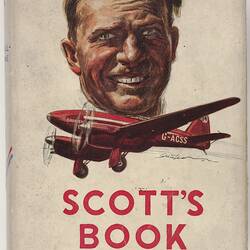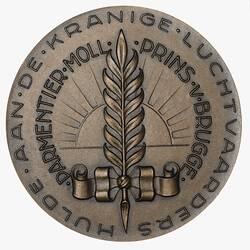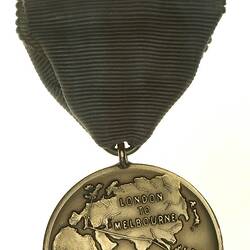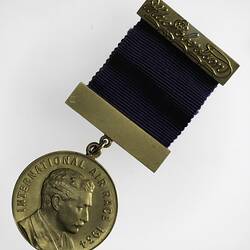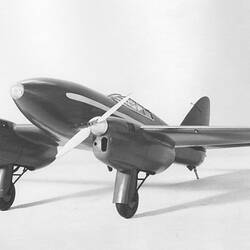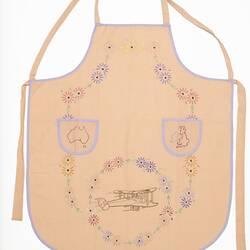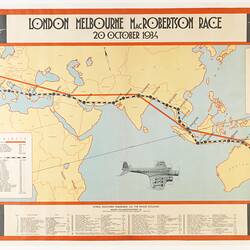Summary
Book titled 'Scott's Book : The Life & Mildenhall - Melbourne Flight of C.W.A. Scott Told by Himself', by John Leggitt, published by Hodder & Stoughton, 1934. This book is biographical account of the life of airman Charles William Anderson Scott who with co-pilot Tom Campbell-Black won the 1934 MacRobertson Centenary Air Race from London to Melbourne in their De Havilland DH88 Comet 'Grosvenor House'.
Physical Description
263 page book with extensive printed black text. The cover has a colour drawing of C.W.A. Scott's face above a drawing of a red airplane. The title is printed in red and sub-title in blue.
Significance
This publication was released just six weeks after the conclusion of the 1934 Centenary Air Race to take advantage of the publicity surrounding the event which has been described as "the greatest single sporting event in the history of flying". Charles Scott had provided a series of interviews to journalist John Leggitt who wrote them as a narrative prior to the race. The last chapter covering the race itself was then cabled back to London along with the photographs of the event included in the book.
The October 1934 Melbourne Centenary Air Race, sponsored by Melbourne philanthropist and confectionery-maker Sir William MacPherson Robertson, proved to be the most enduring event among the many centenary celebrations held in that year. The race was a significant milestone in the development of intercontinental aviation, attracting entries from many of the world's leading pilots and aircraft manufacturers. Although he was born in Britain, Scott had worked as a commercial pilot in Australia for some years prior to 1934 and had previously twice flown the London-Australia route. Scott and co-pilot Tom Campbell Black flew one of three De Havilland DH88 Comet racing aircraft which had been built for the race by the De Havilland Aircraft Co. in Britain. These aircraft incorporated the latest aerodynamic developments including streamlined monoplane design with retractable undercarriage and variable pitch propellers (although these were only adjustable on the ground). However the Comet was made mostly of wood and had limited commercial application. Scott's aircraft was named 'Grosvenor House' in recognition of sponsorship from the Grosvenor House Hotel in London.
The race route covered 18,240 km (11,330 miles) from England to Australia. All competitors in the speed section were required to land at Baghdad, Allabad, Singapore, Darwin and Charleville. Prizes for the race included 10,000 pounds and a gold cup for the overall winner. C.W.A. Scott and Black were the eventual winners, flying between pylons at Flemington Racecourse in front of 40,000 spectators and landing at RAAF Base Laverton on 23 October 1934. Eight planes failed to finish the race. Gilman and Baines were tragically killed when their Fairey Fox crashed near Foggia, Italy. Scott and Black finished the race with an elapsed time of 70 hours, 54 minutes and 18 seconds to win both the speed and handicap sections. Remarkably, second place was taken by an all-metal KLM Douglas DC-2 airliner carrying several passengers and third place by the all-metal Boeing 247D airliner flown by Roscoe Turner. This was a clear indication of the future of air travel. Scott received the 1934 FAI Gold Medal, one of the highest aviation honours for his air race flight.
Scott had a troubled personal history after the air race and committed suicide in April 1946 while working for UNRRA in Berlin.
More Information
-
Collecting Areas
Public Life & Institutions, Transport, Engineering, Images & Image Making
-
Acquisition Information
Purchase
-
Publisher
-
Other Association (See Comments)
Charles W. Scott, London, England, Great Britain, 1934
Charles Scott provided a series of interviews to journalist John Leggitt who wrote them as a narrative prior to the 1934 Centenary Air Race. The narrative became this book with the addition of a final chapter covering the race. -
Author
John Leggitt, London, England, Great Britain, 1934
Charles Scott provided a series of interviews to journalist John Leggitt who wrote them as a narrative prior to the 1934 Centenary Air Race. The narrative became this book with the addition of a final chapter covering the race. -
Classification
-
Category
-
Discipline
-
Type of item
-
References
Flypast: A Record of Aviation in Australia - Neville Parnell & Trevor Boughton, AGPS, Canberra, 1988
-
Keywords
Air Transport, Celebrations, Centennial Air Race, London to Melbourne, 1934, Melbourne Centenary, 1935

